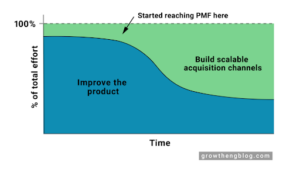All marketers have access to some level of data reporting — but that doesn’t mean they know what to do with it.

At Glamnetic, they do. In a recent conversation with Mozart Data co-founder Peter Fishman, Glamnetic’s Head of Growth, Margaret Fortner, shared her most valuable data-driven marketing lessons, including which metrics to live by and why the right data tools are so critical to success.
Current state of performance marketing
As questions about the U.S. economy loom, particularly regarding inflation and the jobs market, companies are questioning how they can best invest their marketing dollars. While Fortner has noticed some changes, they aren’t necessarily the ones you might expect to see.
It’s easy to understand why marketers would be intent on investing only in the areas where they’re able to directly measure results, but many are actually testing the waters outside the box. Fortner notes, “If anything, people are spending less on performance marketing and testing things like branding a bit more.”
The shift in strategy isn’t only because of economic uncertainty, but has a lot to do with what data is available to marketers since the 2021 iOS update that allowed iOS users to easily turn off tracking when they’re using their device. According to Fortner, companies are saying “it used to make sense to put all of my money into performance marketing because I knew exactly how this audience and this creative were doing at all times.”
Since that’s not the case anymore, companies have become more willing to take chances and test platforms like TV, OOH, and even direct mail. While you can’t track a pixel on a billboard, it’s interesting to note that companies are ramping up their efforts to diversify their marketing platforms and using data (or perhaps a lack thereof) to make those creative choices.
Customer acquisition metrics are evolving
Data-driven marketing is often most focused on the core metrics of growth, particularly customer acquisition. But more and more, companies are seeing just how important it is to unify their strategy around acquisition as well as retention. Fortner notes in the DTC space, “if your acquisition and your retention strategies are not aligned, then you’re going to acquire a lot of really weak cohorts. You’ll be running a ton of sales on the acquisition side or you’re just going to be creating unrealistic expectations by running deep discounts to returning customers and they’re never going to come back again. You need to have those working together as a really strong function.“
Customer acquisition cost vs. cost per acquisition
As the strategy behind customer acquisition evolves, so too has the best way to measure that data. With many different platforms potentially contributing to a customer making a purchase, in the case of a DTC company, customer acquisition cost (CAC) and cost per acquisition (CPA) should be differentiated.
As Fortner puts it, “CAC is a global metric. CAC is not controlled by attribution. CAC is simply all that you spent that day divided by the total number of new customers that came in that day.” On the other hand, “CPA is dependent on platform data. For instance, how much does Facebook report it costs for you to acquire a customer through their platform, in terms of daily cost.”
Attribution triangulation
As companies lost access to a huge amount of usable data with the iOS updates, many also chose to divest from more robust attribution methodologies. But just because your acquisition data may be less accurate than it once was is no reason to underinvest in trying to get to the truth.
Fortner recommends using as many sources as possible, without them becoming overwhelming, and triangulating the truth with a well-honed blend of data and gut. To rely solely on one data source can be a huge mistake because every platform is going to over report their own contributions. Google Analytics (GA), for example, will always give more weight to organic search results, even if many other platforms – Facebook, TikTok, Twitter – all made their own contributions to drive the user to buy. While you can learn the features of your data reporting tools, the more you work with your own customer data, the better tuned your gut will be to what’s actually going on with your specific customers.
Customer lifetime value
While CAC is an essential metric to track, it becomes even more powerful as you learn what a customer is actually worth to the company on a long-term basis. Determining your CAC to customer lifetime value (LTV) ratio is one way to do that. Fortner notes, “Another mistake people will make sometimes is just looking at CAC to average order value (AOV) ratio versus CAC to LTV ratio. One thing within the DTC space is someone can look less profitable at their first order, but over time they can become a very profitable customer if you nurture them well enough.”
Next-level data-driven marketing
As a data-driven marketer, it isn’t enough to merely collect the right data (although that’s certainly important). It’s what you’re able to do with the data that will carry you to the next level. The framework that Fortner uses is: what, why, what’s next?
- What: what happened with your data? E.g., did your CPM go up unexpectedly?
- Why: is there any indicator as to why you saw the change you did?
- What’s Next: how can you make changes, based on what you know of your data and your audience, that you think will address the issue?
As Fortner explains it, “that’s how you really think about being a level one data-driven marketer and being a level three plus data-driven marketer. The basic people are just going to stop at the ‘what,’ but if you really want to be successful it’s about taking those next steps.”
The right data tools are essential to marketing success
No matter how promising a business initiative is, there must be buy-in at higher levels. By choosing data tools that can be implemented quickly and understood without a data engineering background, data-driven teams like Fortner’s set themselves up for success. With some data tools, there is a steep learning curve. In Fortner’s experience, “things can break and then you have to grab the one person who’s really good at it, come in and fix the queries and there can be lots of panic going on during that period of time.”
“We have a great team that builds out the pipelines and does all the dbt transformations and then our leadership team has actually become comfortable enough with Looker that they’re able to go in and build explorers on their own, build their own dashboards, dig more deeply into the data and that’s been really important.”
By leveraging a data stack that’s accessible to a broader range of stakeholders, companies like Glamnetic are able to get a more complete picture of what’s happening in their business and make informed decisions. This is exactly why Mozart Data has made usability a key component of our platform.
To learn firsthand how Margaret Fortner and her team at Glamnetic are leveraging data and leading-edge tools like Mozart Data, watch the whole webinar.


